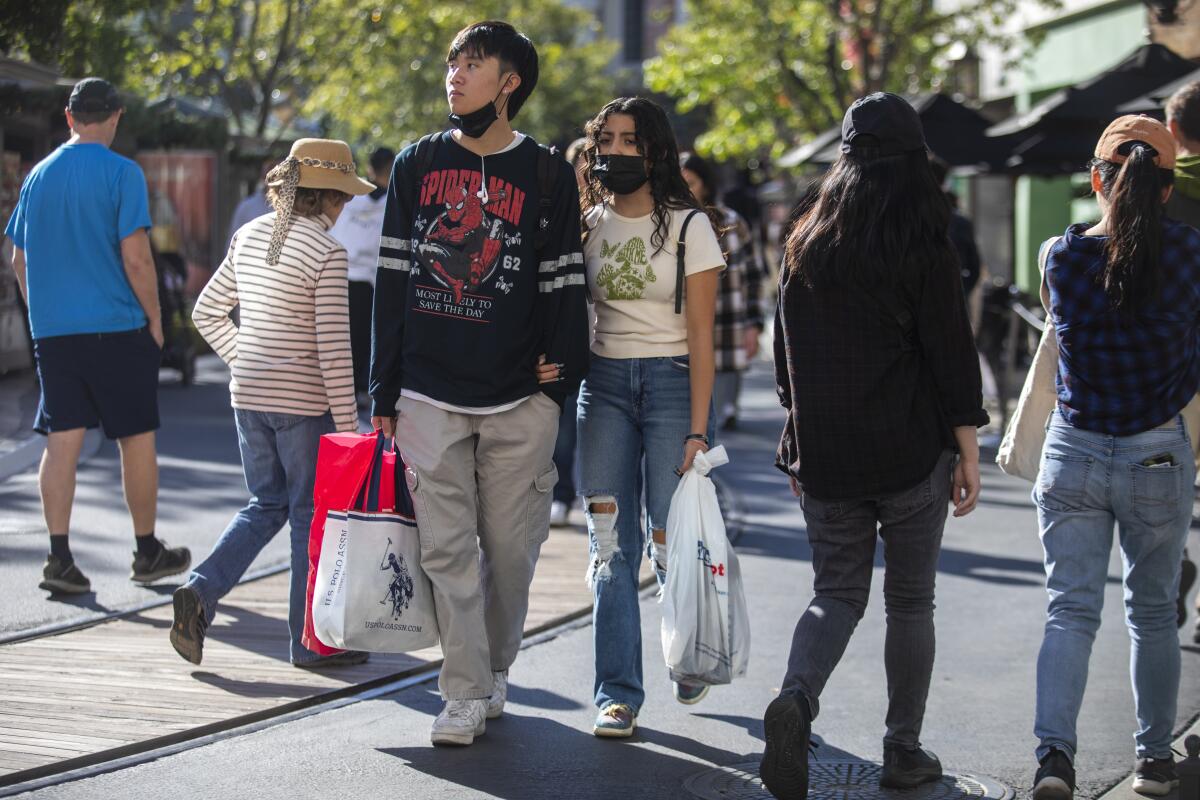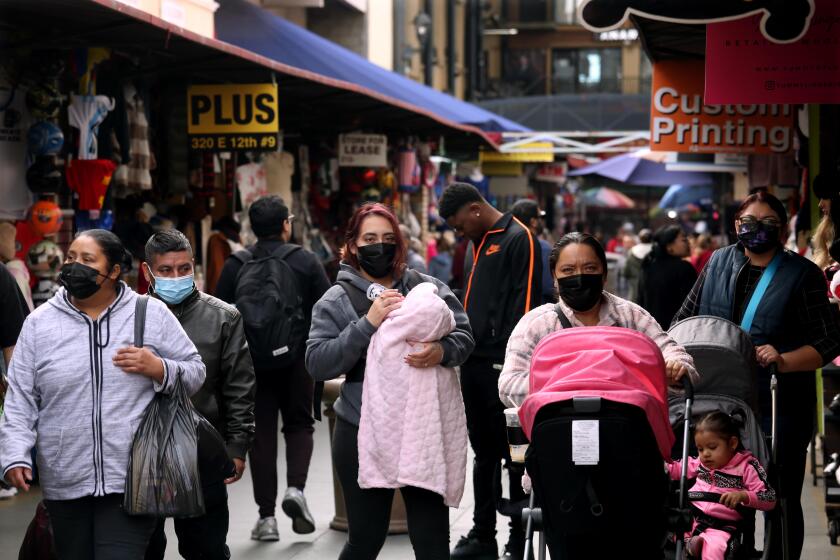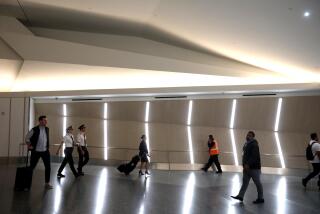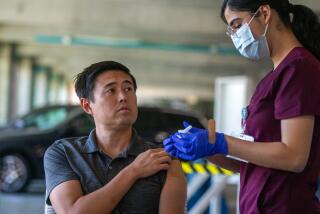On third anniversary of COVID’s arrival, L.A. County ‘in a much better place’

- Share via
Three years to the day after reporting its first confirmed case of COVID-19, Los Angeles County is “in a much better place” in the pandemic — hard-won progress a top health official attributed to vaccination, community immunity resulting from the virus’ rampant spread and development of tools that have blunted some of its worst effects.
In the nation’s most-populous county, reported coronavirus cases have fallen to a level — fewer than 1,000 cases a day — not seen since October, when California enjoyed a lull between last summer’s surge and a shorter-lived spike that began in mid- to late November.
Coronavirus levels measured in the county’s wastewater, a key barometer as many infections are no longer captured in official counts because of the proliferation of at-home tests, also have plummeted in recent weeks.
“These numbers confirm that the decline in transmission is both real and significant,” county Public Health Director Barbara Ferrer said.
California’s COVID-19 metrics have continued to improve since a late fall uptick in coronavirus cases and hospitalizations.
Even amid tempered transmission, COVID-19 continues to exact a deadly toll — with about 140 deaths reported per week for nearly a month. That’s well above the 43 reported the first week of November, the low point during autumn, or the 24 deaths reported during a week in early May, the lull during the spring.
“It’s important that we continue to be aware that this virus is still dangerous and remains a leading cause of death in L.A. County,” Ferrer said.
But, she said, “hopefully the decline in transmission will be followed soon by a decrease in deaths.” She said a more stable death rate would be about 35 COVID-19 deaths a week. Such a number might still be difficult to accept — especially since such deaths are now largely preventable with vaccines — but would nonetheless represent stability and “indicate that our protections are really working extraordinarily well.”
Those measures include staying up to date on vaccines, wearing a mask in indoor public settings, testing regularly to confirm infection status, remaining home when sick and promptly seeking treatment if necessary, Ferrer said.
“While there remains uncertainty moving forward because the virus continues to mutate, our metrics provide clear evidence that our community immunity level and protective measures have lessened the impact of COVID-19 on many residents and workers in our county,” she said.
Another factor, she said, is that the sprawling Omicron family has dominated the viral landscape for more than a year.
“We have done our very worst when we have gone from one variant to another,” she said. “We went from Delta to Omicron, and Omicron devastated us that first winter.”
Los Angeles County has seen marked improvement in its pandemic metrics. A much-discussed double COVID wave fueled by gatherings and travel has not materialized.
But a period of relative stability has allowed officials to better hone their tools and help ensure residents remain well protected.
“We know our vaccines are effective against Omicron. They’re working really well,” Ferrer said. “Some of us have been infected with Omicron, and we have some natural immunity. That combination, I think, is really helping us this winter.”
California, like L.A. County, is noting steady improvements. And barring some late-season reversal of fortune, this winter is set to be the most moderate of the pandemic by far.
According to a Times analysis of state data, reported daily coronavirus cases peaked in early December at about 12,345, or 221 cases a week for every 100,000 residents. (A rate of 100 or more is considered high.) That’s 10% of the peak seen about a year ago, when the state was reporting 123,611 cases a day.
In Los Angeles County, the number of coronavirus cases this fall and winter peaked at 3,929 a day during the first week of December, or 272 cases a week for every 100,000 residents. That’s 9% of last winter’s peak, when the county was reporting nearly 42,000 cases a day.
Transmission has now declined to the point that L.A. County health officials have relaxed their broad recommendation that everyone mask up indoors while in public.
Wearing a face covering is still required in certain settings, such as healthcare facilities and nursing homes, and encouraged aboard public transit. But for most, the decision to mask up is now considered a matter of personal preference.
Using machine learning, scientists have trained computers to comb the internet and recognize the early signs of a COVID-19 surge up to 6 weeks in advance.
The number of coronavirus-positive patients statewide also has continued its steady march downward. As of Thursday, the number of such people hospitalized statewide was just under 2,700 — the lowest since Thanksgiving.
Since the height of the latest winter surge — 4,648 coronavirus-positive patients on Jan. 3 — the number has fallen 42%. Still, that is 78% higher than the autumn lull of 1,514.
The most recent high hospitalization mark was about one-third the peak of the initial Omicron surge: 15,435 on Jan. 21, 2022. During the pandemic’s first winter wave, nearly 22,000 coronavirus-positive patients were hospitalized on some days.
According to modeling forecasts, coronavirus cases and hospitalizations are projected to continue declining for at least the next few weeks. State officials noted, however, that “these projections are dynamic and may change due to unpredictable events such as emerging variants.”
“While cases and hospitalizations are projected to continue declining, COVID-19 hospital admission rates are elevated across the state and emergent variants such as XBB.1.5 remain a concern,” the California Department of Public Health wrote in a statement to The Times.
As a result, “Californians are encouraged to remain vigilant by staying up-to-date with vaccinations, staying home when feeling ill, wearing a high-quality mask to protect the vulnerable, and testing after possible exposure,” the department said.
A preliminary study in Israel finds that seniors who received an Omicron-targeting booster shot were 81% less likely to be hospitalized with COVID-19 than those who skipped it.
Some officials and experts expressed concern that XBB.1.5, described as perhaps the most infectious edition of the coronavirus, could drive a fresh surge in infections and hospitalizations.
But it appears another spike is not in the cards, at least for now.
Dr. Eric Topol, director of the Scripps Research Translational Institute in La Jolla, noted Wednesday that the U.S. had passed through the peak of the subvariant-fueled wave — with a more than 30% reduction in hospitalizations over the last two weeks.
“This reflects a high level of infection and vaccine-induced immunity relative to a troublesome variant,” he wrote on Twitter.
Though XBB.1.5 is the dominant version of the coronavirus nationwide, that does not appear to be true for California. State health officials most recently estimated its proportion at 33.9%, behind BQ.1.1’s 38.6%.
The new plan would make COVID-19 inoculations more like the annual flu shot, saving Americans from having to keep track of how many shots they’ve received.
It’s not inconceivable that case trends could reverse as XBB.1.5 expands its footprint in California. But that’s not a certainty. The subvariant also could supplant its sibling strains without boosting case rates.
And even if cases rise, it’s not a given that will lead to substantially more people falling seriously ill and renewing stress on the healthcare system. Though more infectious, it’s unclear whether XBB.1.5 is more virulent than preceding subvariants.
“From reports by several countries, no early signal of increase in severity has been observed, however the number of cases associated with XBB.1.5 is still low, so it is difficult to assess severity,” the World Health Organization wrote in an epidemiological update Wednesday.
The updated COVID-19 booster shot — available since September — has helped prevent illness from the Omicron XBB-related variants, according to a report published Wednesday by the U.S. Centers for Disease Control and Prevention. The new booster is known as a bivalent vaccine.
“Bivalent vaccines appear to provide additional protection,” said the release, published in the Morbidity and Mortality Weekly Report. “All persons should stay up to date with recommended COVID-19 vaccines, including receiving a bivalent booster dose when they are eligible.”
More to Read
Sign up for Essential California
The most important California stories and recommendations in your inbox every morning.
You may occasionally receive promotional content from the Los Angeles Times.




















